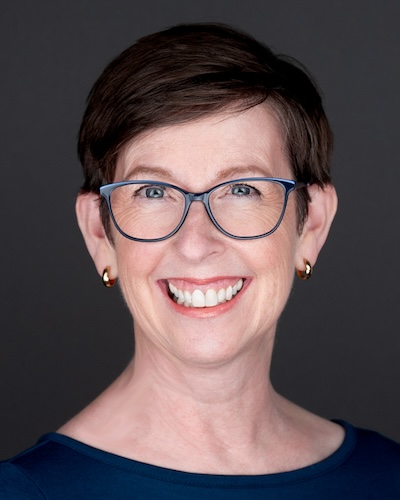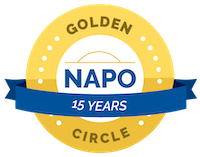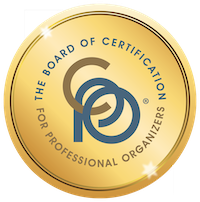Are you interested in becoming a professional organizer? (2023 update!)
I originally wrote this post in 2011 and asked colleagues to add to it in the comments. It has become my most popular post. I’ve updated it every three years since. For this post, I deleted links (and comments) that are no longer current and added some of the information shared in the comments into the body of the post. I’ve also updated some of the text.
I’ve also created a newsletter just for new and aspiring professional organizers. Sign up for my organizers mailing list and I’ll send you my guide, Five Questions to Ask Yourself Before Starting an Organizing Business!
I regularly receive emails from people who are interested in becoming a professional organizer, asking me if I am hiring or asking how to start an organizing business. It occurred to me that I could save them the time writing (and be helpful to people too bashful to write), if I created a blog post with the information I usually write to these folks. That’s worked out well—I also suggest the people who do write me read this post if they haven’t already.
So here’s what I think you need to do to become a professional organizer:
Love people. In my experience, being a PO is more about the people and less about the organizing. Of course you should love organizing as well, but if you don’t love working with people (and if you can’t stop yourself from judging the organizationally challenged), this might not be the field for you.
Invest in professional association memberships. The first thing I did when I decided to become a PO was to join the National Association of Professional Organizers. (NAPO has since changed its name to the National Association of Productivity and Organizing Professionals, while maintaining the acronym NAPO.) I would have joined a NAPO chapter instantly, but St. Louis didn’t have one back in 2005. A chapter was formed in 2006 (I was a founding board member) and we have strong, collegial chapter that I’m proud to be a part of. Joining NAPO not only gives you credibility, it gives you access to the knowledge of a thousands of organizers through its chapters and its online communities and conferences. NAPO has a free Guide to Getting Started in the Organizing and Productivity Profession with information on how NAPO can help you start your organizing business. Go to NAPO.net, click on Resources in the menu bar, then “Getting Started” in the drop down menu.
If you live outside the U.S., you can join NAPO, but you might also want to check if there’s an organizers’ association in your country. The IFPOA is a good place to start. My friend Geralin Thomas of Metropolitan Organizing has a great blog post called Why Join NAPO: Demystifying NAPO Membership for New Professional Organizers.
Invest in training and education. The second thing I did when I started my business was join the Institute for Challenging Disorganization (back then it was called the National Study Group on Chronic Disorganization). I started taking their teleclasses immediately; not only were they a great education for me, they also gave my confidence a boost. The classes are now offered as webinars and ICD offers a rich vault of on-demand classes to its premium subscribers.
NAPO also offers excellent education for professional organizers through its NAPO University. They’re available on-demand to take at your convenience. If you’re an aspiring organizer, pay close attention to the lower-cost two-hour class, OD1-001 Introduction to Professional Organizing and Productivity. I took two NAPO education classes my first year of business (OD1-104 Starting an Organizing Business and the equivalent of OD1-101 Fundamental Organizing and Productivity Principles and OD1-102 Fundamental Organizing and Productivity Skills). NAPO’s course offerings are much more extensive now.
NAPO’s membership structure has changed since I started out. Now, when you join, you are considered a provisional member until you complete ten hours of Professional Practices courses. I applaud this emphasis on education and professionalism!
If you’re interested in specializing in managing senior moves, the National Association of Specialty and Senior Move Managers has great educational resources and a certification, as does The Photo Managers (formerly the Association of Personal Photo Organizers), for those interested in organizing photos for their clients.
Invest in conferences. I love conferences. There’s no better way for new organizers to learn about the industry, in my opinion. I went to the first NAPO and NSGCD (now ICD) conferences that were available after I became a PO. And I continued going every year until COVID hit. In all, I’ve attended 13 national NAPO conferences, ten ICD conferences and three NAPO regional conferences. I even attended the Australasian Association of Professional Organizers conference in Brisbane, Australia, in 2009! Here are some conferences to take note of: The 2023 NAPO Summit in Las Vegas, March 30 to April 2-5, 2023, the 2023 ICD Conference in Waltham, Massachusetts, September 21-23, 2023 and the Professional Organizers in Canada 2023 Virtual Summit on October 26, 2023.
Think about a training program. A number of professional organizers offer training programs for new POs. I haven’t been through any of their programs myself, but here are some of the more prominent ones:
Get coaching from another organizer. One great way to get personalized help is to hire an organizer to work with you one-on-one with you, either in person or on the phone. It’s a great way to get all your questions answered, with a laser focus.
- Geralin Thomas of Metropolitan Organizing will answer any and all of your questions in her 60-minute Ask Me Anything phone coaching calls. (Hire her once or many times.) She also offers forms that organizers can use for their own businesses. And she has a glossary for organizers, called Terms of the Trade, which can be particularly helpful to new or aspiring organizers to get up to speed on the terminology in our industry. (You can also check out her article on Fast Track Training to Become a Professional Organizer. And don’t miss her Ask Me Anything videos, which I write about in this blog post, Must-see videos for new organizers.)
- Kathy Vines of Clever Girl Organizing coaches new and experienced organizers. See her coaching page to read about her coaching services
Get your website going. I think a good website is absolutely essential. (I rarely hire service providers who don’t have one.) I know for a fact that my website brings in the majority of my business. It was designed by the fabulous web designer Nora Brown. If you’re a DIY type, you might consider creating your own website—though I think hiring someone is a good investment. I created my other blog, Organize Your Family History, myself on Wordpress and it was much more time consuming than I expected. I ended up hiring a graphic designer to create a header for it because my DIY one was not up to snuff.
Do freebies if necessary. In my first six months of business, I did freebies for friends in exchange for testimonials and before-and-after pictures for my website. It gave me valuable, relatively low-stress organizing experience (we took these sessions very seriously) and it helped me build my website. That worked very well for me.
See if you can help on teams. Here in St. Louis, experienced organizers sometimes put together organizing teams for big jobs and use other organizers as contractors. I’ve built my business around that model, though I now have employees. It can be a great way to learn on the job (and get paid while you’re at it). I suggest joining a NAPO chapter, if there’s one near you, and letting other members know you’re interested in working on teams. If there isn’t a NAPO chapter, just reach out to organizers in your area.
Listen to a podcast. NAPO has a terrific podcast called Stand Out that’s created for professional organizers and aspiring professional organizers. I recommend listening from the beginning and subscribing (it’s free). You might also benefit from listening to business- or entrepreneur-related podcasts or any podcast that helps you understand your target market.
Don’t ignore social media. When I was starting out, social media as we know it wasn’t in existence, but I did start blogging fairly early on. Blogging has been exceedingly helpful in drawing traffic to my website. Other types of social media can also drive traffic to your website, give you a presence outside (as well as inside) your local area and help build relationships with colleagues and companies in related industries. There are many opportunities to increase your profile through social media, including Facebook, Instagram, Twitter, YouTube and TikTok. If that feels overwhelming, I suggest choosing one social media outlet and try to create a presence there.
Becoming a professional organizer is a fairly low-overhead proposition. But I’d urge you to invest in professional associations, conferences, training or classes, coaching and website development. I’m awfully glad I did.
If you’re wondering what you might get out of becoming a professional organizer, check out the blog post I wrote in January 2013, Why I’m a professional organizer. If you’d like to dig a little deeper, download my Five Questions to Ask Yourself Before Starting an Organizing Business and sign up for my mailing list for new organizers.
You may also want to check out my New Organizer Bundle that includes five guides that go into much more depth than a blog post can. See what’s in the Bundle.
I’d like to thank all the POs who have already enriched this blog post by adding comments (please be sure and read them). If you’re a PO, feel free to add your two cents if you haven’t already!
Worth repeating: The value of joining a NAPO chapter
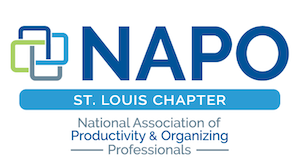
I spent the morning at the monthly meeting of the St. Louis chapter of the National Association of Productivity and Organizing Professionals. It was so enjoyable and valuable that I decided to re-run an updated version of this post, which I originally wrote in 2016. If you’re a professional organizer and you don’t already belong to your local NAPO chapter, I encourage you to join!
If you’re a professional organizer, I hope you’re lucky enough to live where there’s a local chapter of the National Association of Productivity and Organizing Professionals. And if you do live near one, I hope you’ve joined it! (If you don’t live near one, you can join NAPO’s Virtual Chapter, which is also great. I’m a member of that chapter too!)
When I started Peace of Mind Organizing® in 2005, the first thing I did was join NAPO. The second thing would have been to join NAPO-St. Louis, except it didn’t yet exist. Thanks to the hard work of others, the chapter was established in 2006 and I was lucky enough to be a founding board member.
Through the last 17 years I’ve remained involved with the chapter, serving on the board for the first six years of its existence, then taking three years off before joining the board again for another four-year stint. I took two years off and am just finishing up another two-year term on the board. That’s 12 years of volunteer board service; clearly I’m invested in the chapter.
Why do I devote so much time and energy to the chapter? Because it gives so much back to me. Here are a few of the benefits of chapter membership:
- Camaraderie. For new and veteran organizers alike, the opportunity to spend time with like-minded people sharing advice and experiences is invaluable.
- Leadership experience. I’m pretty sure I wouldn’t be as good at leading my organizing teams if I hadn’t had the experience of being president of the chapter from 2008-2010. (And again from 2015-2016.) It helped form the kind of leader I’ve become.
- Education. NAPO-St. Louis meets in person nine times a year and virtually twice a year. The chapter’s programs are really valuable. We use both outside speakers and have programs presented by chapter members—there’s an amazing wealth of knowledge among our membership! The chapter also makes conference recordings available to its members as a membership benefit. (I’m certain this is a common chapter benefit.)
- Visibility. All chapter members are listed on the NAPO-St. Louis website, giving them another exposure to prospective clients.
- Referrals. When chapter members receive inquiries from clients they might not be right for, they’ll sometimes send them to me. And vice versa.
- Client resources. We have 13 Business Partner members of NAPO-St. Louis and I refer clients to them all the time. I can also look for resource recommendations from fellow members of the chapter on our online forum. The chapter makes me a better resource for my clients.
- Business development. These days I focus my business on organizing teams. All my team members, employees and independent contractors alike, are NAPO-St. Louis members. I’ve made it a requirement, because I want to use independent contractors who have shown a dedication to their businesses by joining NAPO national and NAPO-St. Louis. I can assure my clients that all my team members abide by NAPO’s Code of Ethics.
I honestly don’t know where my business would be without NAPO-St. Louis, but I’m pretty sure it would not have grown like it has. If you’re a PO or an aspiring PO I urge you to get involved with your chapter. It will reap huge dividends!
If you’re a member of a NAPO chapter, please feel free to comment on what you get out of your chapter!
My aspiration for 2023
I saw on meme on Facebook late last year that spoke to me. I copied down the words onto a Post-it Note® and put it on my bulletin board. I thought I’d share that note with you today:
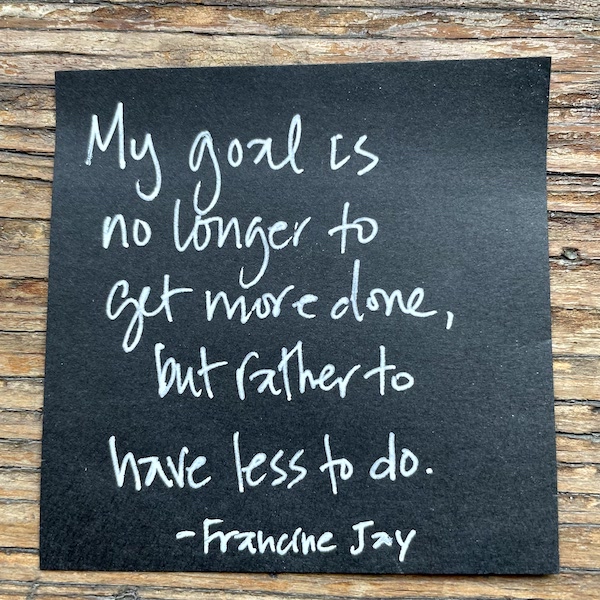
So far I’m not doing a great job of having less to do but I’m trying! In the meantime, I’m keeping these words top of mind as an aspiration. I hope by end of the year, it will be true!
KC Davis's 5 Things Tidying Method
I just became of this terrific video by KC Davis that I think will be useful to people who are overwhelmed by clutter and don’t know where to start.
Here are some of the things I love about the method illustrated in this video, in which KC Davis suggests focusing on only five things (one at a time) to gain control of a room and create some visual peace:
- It makes creating order in a cluttered space feel doable
- It embraces imperfection
- It helps people figure out a place to begin, which is often the hardest part
If this leaves you wanting more, here’s a link to KC’s YouTube Channel, where she has a few videos (she has more than 13,000 subscribers). For more videos, check out her TikTok channel, where she has a million and a half subscribers! I don’t do TikTok, so that might be why I’m late to the game here.
I also wanted to share a link to her Struggle Care website, where you can find information about her Struggle Care podcast, her book, How to Keep House While Drowning and her online course.
Struggle Care’s tagline is, “When everyday care tasks are a struggle.” If you’re living with depression or finding it difficult to take care of your home, I encourage you to check out KC’s offerings in whatever format you prefer. (She has a TedX talk on her website, if that’s what you like.) She treats this topic with kindness and compassion.
Worth repeating: Decluttering my {knitting} WIPs
I wrote this post 3.5 years ago, but I can still feel the thrill of letting go of knitting projects I didn’t want to finish and either reclaiming or giving away the yarn. Have I finished the projects I intended to finish? I don’t know! Time for another WIP decluttering session.
In knitting, WIP stands for Work-In-Progress. In my knitting reality, almost all my WIPS are actually stalled and/or abandoned projects. They languish in (mostly hand knit) bags in my knitting area creating clutter and a little bit of stress. That area was like a graveyard for knitting dreams.
But then I came across the book Untangled: A step-by-step guide to joy and success for the modern yarn lover by Shelley Brander. Untangled and its chapter The WIP-It Challenge inspired me to go through and declutter all those bags.
It took the better part of a Sunday and it was so liberating! Here’s how I did it.
I gathered up all those bags. Here’s a photo of them—I had no idea there were so many.

I ended up taking them to the dining room table and where the light was good, I went through them one by one. I started a little spreadsheet of each project, what yarns and needles it called for, the progress I’d made and what I wanted to do with it.
In all, I counted 15 WIPs. I took five of them off the needles and unraveled the yarn. That felt so good because that beautiful yarn got a new life, instead of being cooped up in a bag. I have a ball winder, so I had some very satisfying time winding all that yarn into neat balls. (See the picture below of the yarn I reclaimed in this project.) One of the abandoned projects was a toy I’d started making as a baby gift five years ago. I’d knit the component parts but before seaming them together, I realized that it wasn’t cute enough to give to the baby. I put it away thinking I’d finish it some day, I guess. Instead, I threw away all but the body and gave the body to my standard poodle, Bix, who thinks it’s a great toy.
Here’s a photo of Bix with the toy. He doesn’t care that it’s a reject. (In case you’re wondering, the finished toy was supposed to be Yoda.)
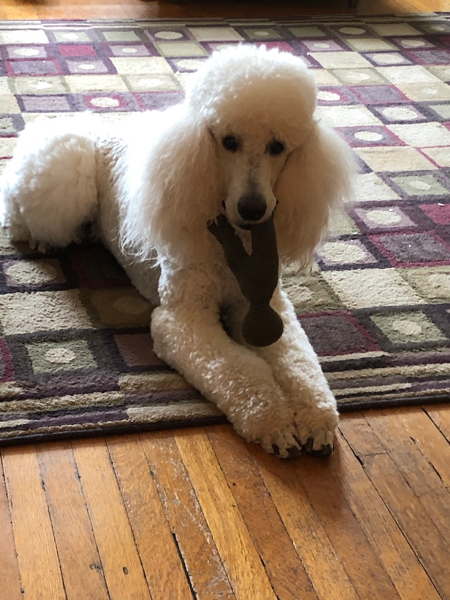
Here’s the reclaimed yarn! The photo doesn’t include the yarn that doesn’t thrill me, which I’d set aside to give to friends.
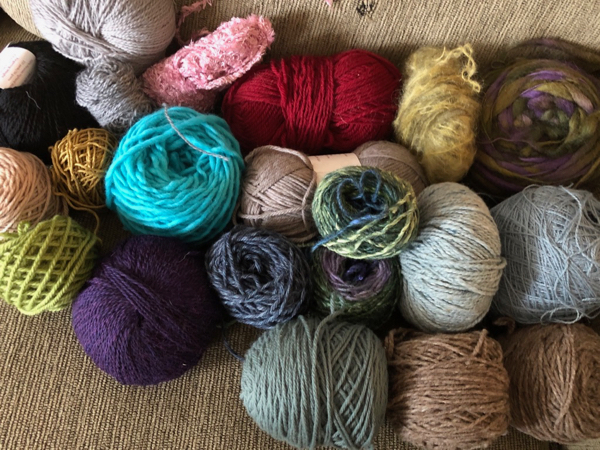
Of the remaining WIPs, four were fingerless gloves or mittens, with one finished. (There was also a pair of yoga socks with one completed.) I decided to hang on to those and finish them. There was a hat whose yarn I purchased to make a gift. I unraveled it and will start again. And there was a sweater whose yarn and pattern I had bought but had not actually starting knitting. I had completely forgotten about it (it’s very cool). So I’m going to evaluate the pattern and see if there was a reason I walked away from it.
One of the projects, was so close to being completed. It just had a tiny bit of seaming left to do. It was a striped cowl that I literally worked on for years. But when it didn’t end up as expected during construction, I walked away from it. But in the weeks after the big declutter, I actually finished it and now I have a cozy-warm cowl I can wear.
This process was absolutely rejuvenating. Not only did I get rid of a bunch of unsightly clutter, I let go of projects that were weighing me down, even if I didn’t realize it. I liberated yarn and needles to use in other projects. And I got excited about knitting again.
The day after this exercise, my co-host Shannon Wilkinson and I recorded an episode of our podcast, Getting to Good Enough, called Restarting that was all about this little adventure. If you’re interested in any more details of the knitting-project decluttering and its implications, please give it a listen!
Organizers: Check out the free Business Simplicity Summit next month!
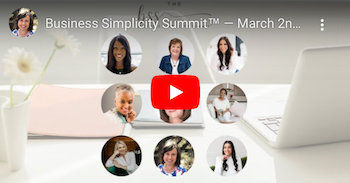
If you’re professional organizer or other small business owner, I encourage you to check out the Business Simplicity Summit being organized by Molly Winters, The Connection Copywriter. I’ve worked with Molly—she’s a terrific writer and wonderful business person. She’s put together a slate of nine speakers who will talk on topics around building simplicity into your business. I just registered!
One of the speakers, Geralin Thomas, is one of my dearest friends and absolutely full of wisdom. She alone is a reason to sign up for this free online summit! In addition to Geralin, my friend Anne Blummer of Institute for Professional Organizers, is speaking, as is Molly herself. And there are six other experts speaking on topics ranging from Simplified Ways to Add Revenue Streams to Your Small Business to Simplified Self Care.
You don’t have to be a professional organizer to attend. All are welcome!
Here are the details:
The Business Simplicity Summit™
March 2nd & 3rd, 2023
Times throughout the day beginning at 8 am PST
Online via Zoom
FREE Event
Register Here
I'm a "Storage Doctor" in new Secrets of Getting Organized magazine!
Once again, I am thrilled to be a part of the new (early spring 2023) issue of Secrets of Getting Organized magazine from Better Homes & Gardens! I am always happy to be interviewed for this magazine and so pleased to be one of the regular organizing experts the editors reach out to.
Back when I wrote about pets for magazines, I bought and read magazines all the time. But nowadays, I get most of my information online. So getting the new issue of Secrets of Getting Organized magazine in the mail is always a treat. It’s advertising-free, beautifully photographed, and full of great advice from professional organizers. (There’s an article in this issue about someone who transformed their garage into a guest house that really floated my boat!) In this issue, I’m quoted in the Storage Doctor: Clutter Cleanse section on bathrooms in the front of the magazine. It starts on page 4.
The magazine is on sale now at newsstands, grocery stores, big box stores, etc. It will remain available until March 16, 2023.
Here’s the cover so you can easily spot it on the newsstand.

Search
Recent Posts
- Budgeting and decluttering: It's all about priorities
- Today's truth bomb
- Worth repeating: Labels in the refrigerator
- The meat of my Bullet Journal
- Worth repeating (again): Getting past "I might need it some day"
- Furthering your goals one tiny step at a time
- Repeating spreads in my Bullet Journal
Tags
Links
- NAPO St. Louis
- Organize Your Family History
- Peace of Mind Spending
- Getting to Good Enough podcast
- Shannon Wilkinson, life coach
- Ravelry
- Are you interested in becoming a professional organizer?
- National Association of Productivity and Organizing Professionals
- Institute for Challenging Disorganization
